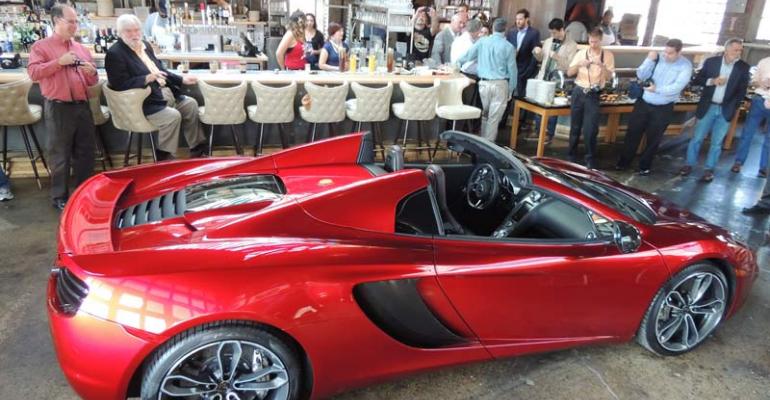BERKLEY, MI – McLaren, a brand associated more with racing than volume production vehicles, makes good on its promise to expand the portfolio of road-ready sports cars by unveiling in metro Detroit the convertible version of the MP4-12C.
The ’13 12C Spider was unveiled recently at the Pebble Beach Concours d’Elegance, and assembly of the sleek roadster with a retractable hardtop and dihedral doors begins next month at the McLaren Production Center in Woking, U.K., which opened last year to begin building the initial coupe version of the MP4-12C.
McLaren has sold 450 12C coupes in the U.S. since the car went on sale early this year. Company officials told journalists during a spring tour of the Woking plant that 1,900 coupes and convertibles could roll out of the plant by year’s end.
In the U.S., the 12C Spider carries a base price of $265,750 – a $25,000 premium over the coupe. The price does not include optional equipment or a $2,400 shipping fee. First U.S. deliveries are expected in early 2013.
Despite the price of entry, Richard Powell, aftersales manager for McLaren in North America, says he has spoken with several customers who own 12C coupes and also plan to purchase convertible models.
The retractable hardtop folds and stows within 17 seconds, and the procedure can be done while the car is moving up to 19 mph (30.6 km/h). The folding top adds 88 lbs. (40 kg) for an overall curb weight of 3,033 lbs. (1,376 kg) for the new Spider.
With the top up, the only differentiating feature is a seam along the center of the top, allowing it to fold in two pieces into a bin behind the seats and in front of the 616-hp twin-turbo 3.8L V-8. Compared with the previous model, the ’13 coupe and convertible produce an extra 25 hp. The torque rating remains unchanged at 443 lb.-ft. (600 Nm).
Mechanically, the coupe and convertible are identical, each using a 7-speed Graziano dual-clutch transmission, carbon-fiber monocell with aluminum front and rear subframes and a rear-wing airbrake that rises during hard deceleration to keep the back end planted.
A rear windscreen, mounted directly behind the seats, can be raised or lowered with the top up or down. With the top down, the glass screen improves aerodynamics and minimizes disturbances for occupants. With the top up, the screen can be lowered to allow more engine sound into the cabin.
New for ’13 is a bold exterior color, Volcanic Yellow. The car displayed here and at Pebble Beach was Volcanic Red.
The U.S. is McLaren’s No.1 market for the 12C, comprising about a third of all sales. The car is available at 38 dealerships in 22 countries. The U.S. has nine showrooms.
More dealers will be added in the next few years, Powell tells journalists at the Spider unveiling here.
Dealers are allocated a certain number of build slots per month, and models are built-to-order based on customer requirements. It takes about three months for orders to be filled, Powell says.
The Woking plant employs 400 people, who build eight vehicles per day on one shift. Powell says he expects 80% of MP4-12C production will be dedicated to convertible body styles for the near future.
A visit to the factory by WardsAuto earlier this year found a spotless and brilliantly lit facility with no fixed conveyors. Instead, each vehicle rests on a mobile build fixture. Vehicles advance from one assembly station to the next every 45 minutes.
Well-heeled customers come to the white-and-gray plant to see their 12Cs being assembled by hand in near silence, because there are no presses or other heavy equipment. Beyond casual conversation, the only sound heard near the assembly line is the gentle click of a rachet wrench.
McLaren plans to introduce two additional model ranges within the next 10 years, which could drive up production to about 4,000 units at the Woking facility.
“There will probably be a new model or a variant of a new model introduced each year,” Powell says. “We want three distinct cars that fit into different segments of the business.”




